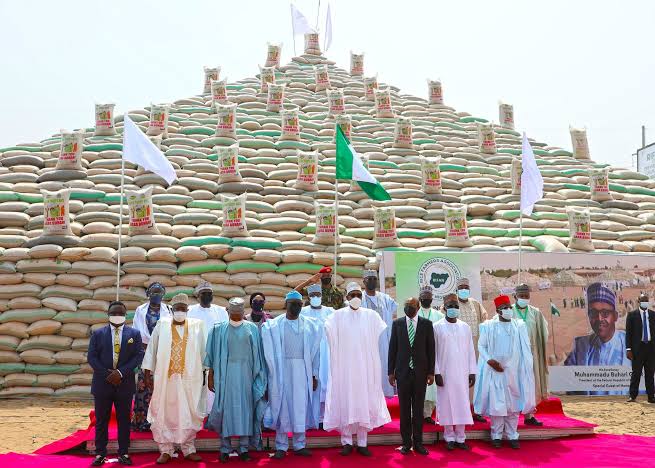Editorial
Showboating With Paddy Rice Pyramids In Abuja

By pleading patience from Nigerians over the sky-high price of rice during the launch of the “sky-high” rice pyramids in Abuja on Tuesday, President Muhammadu Buhari and his speechwriters must have sensed that they were putting the cart before the horse with the photo-up and that Nigerians were not moved. Naija News expects that before this showboating, the commodity should have been made widely available and affordable. Indeed, the logistics incurred as a result of the unveiling ceremony would have been more useful if spent on processing the paddy and ensuring seamless distribution to Nigerians.
Speaking during the official commissioning of the Central Bank of Nigeria (CBN)/Rice Farmers Association of Nigeria (RIFAN) Rice Paddy Pyramids at the Abuja International Trade Fair Complex, Buhari said, “I am aware that the bags of paddy will be moving straight from here to rice milling plants across Nigeria, which lead to the release of processed rice to the markets by the rice millers.” The Buhari administration’s quest to make Nigeria self-sufficient in rice production is highly commendable considering that 1.3 million metric tons of rice were imported to Nigeria from Thailand in 2014.
The rice revolution being witnessed in Nigeria is powered by the Anchor Borrowers’ Programme (ABP), put together by the CBN in collaboration with commercial banks in the country. Under this funding arrangement, the banks lend to farmers with a guarantee for off-takers to buy the produce from them during harvest.
Since the launch of ABP in 2015, there have been consistent reductions in rice imports from that Asian country. As of 2016, rice imports from Thailand had dropped to only 58,000 metric tons and a mere 2,160 metric tons at the end of 2021. This is in addition to increasing national rice output from about 5.4 million metric tons in 2015 to over nine million metric tons in 2021.
At the fanfare in Abuja on Tuesday, the President launched 1.2 million bags of paddy rice stacked in 13 pyramids. Each of the paddy pyramids was built with 115,000 bags, of 100kg each. We expected that at least 100th fold of this ton should be circulating in markets across the country before the unveiling of what has been termed the biggest rice pyramids in Africa.
With rice readily on the table of Nigerians, the circus at the International Trade Fair Complex in Abuja would easily live up to the picture which the government was labouring to paint and get the buy-in of Nigerians. Where is the wisdom of conveying millions of paddy rice bags to Abuja and stacking them in 13 pyramids when the produce should have gone straight to millers who would hasten their availability to famished citizens? This is more so considering that the cost of the staple is at an all-time high. At the inception of the Buhari administration in 2015, a bag of rice sold for N10,000, today the same is averaging at N30,000. Yet, the former price was at a time when “there were only 15 standard Rice mills in Nigeria”.
Buhari assured that the rice pyramids “will aid our efforts at reducing the price of rice in Nigeria”. It remains to be seen how this will be given that similar pyramids had been launched in other parts of the country without pushing down the price of the staple. The President also disclosed that the Anchor Borrowers’ Programme of his administration has brought about “over 50 Standard and integrated Rice mills”. Despite this “feat”, the bragging right of the administration is to display bags of paddy instead of already processed rice.
It is therefore no wonder that what Nigerians have on their hands is a case of ‘water, water everywhere and not a drop to drink’. It flies in the face of reality for these paddy pyramids to be celebrated when Nigerians spend about 90 per cent of their income on food. The latest inflation data from the National Bureau of Statistics indicates that the composite food sub-index rose to 17.37 per cent in December 2021. Rice, which should be a staple, is so out of reach that most households only get to eat it during special occasions or on Sundays or Fridays depending on their faith. Yet, the Nigerian government will want the world to believe that rice has become very common in the country. Those in charge of the affairs of the country will do well to get their priorities right.
While Nigeria is building pyramids as if it has arrived in terms of rice production, countries like China, India, Thailand, Bangladesh and Vietnam that produce over 50 per cent of rice consumed globally take their ability to feed their people and the world for granted. So, this stunt won’t fetch Nigeria a place in the Guinness Book of Records. If it’s about a nostalgic reenactment of the famous groundnut pyramids in Kano. The circumstances, drive and utilities are different. Kano’s groundnut pyramids were located at strategic sites where they were routed through railway to the seaports, for onward shipping to their destinations abroad. In the case of the paddy pyramids, they were unnecessarily displayed in pyramids from where they will be transported to the mills!
Meanwhile, Naija News cannot but notice the palpable absence of the Ministry of Agriculture in all of this conversation. Why is this heavily funded ministry of the federal government playing possum on what should ordinarily be its responsibility? Granted that CBN is trying to conserve foreign exchange by using the ABP to stop the importation of commodities that can be grown locally, this does not mean that the Ministry of Agriculture shouldn’t be alive to its responsibilities. The central bank has so much to do for the fiscal and financial stability of the country that it mustn’t add to its already filled plate what should be handled by the federal and state ministries of Agriculture. It is wholesale intervention like this that makes the Federal Ministry of Agriculture and Rural Development idle enough to go about constructing a mosque with N30 million!












